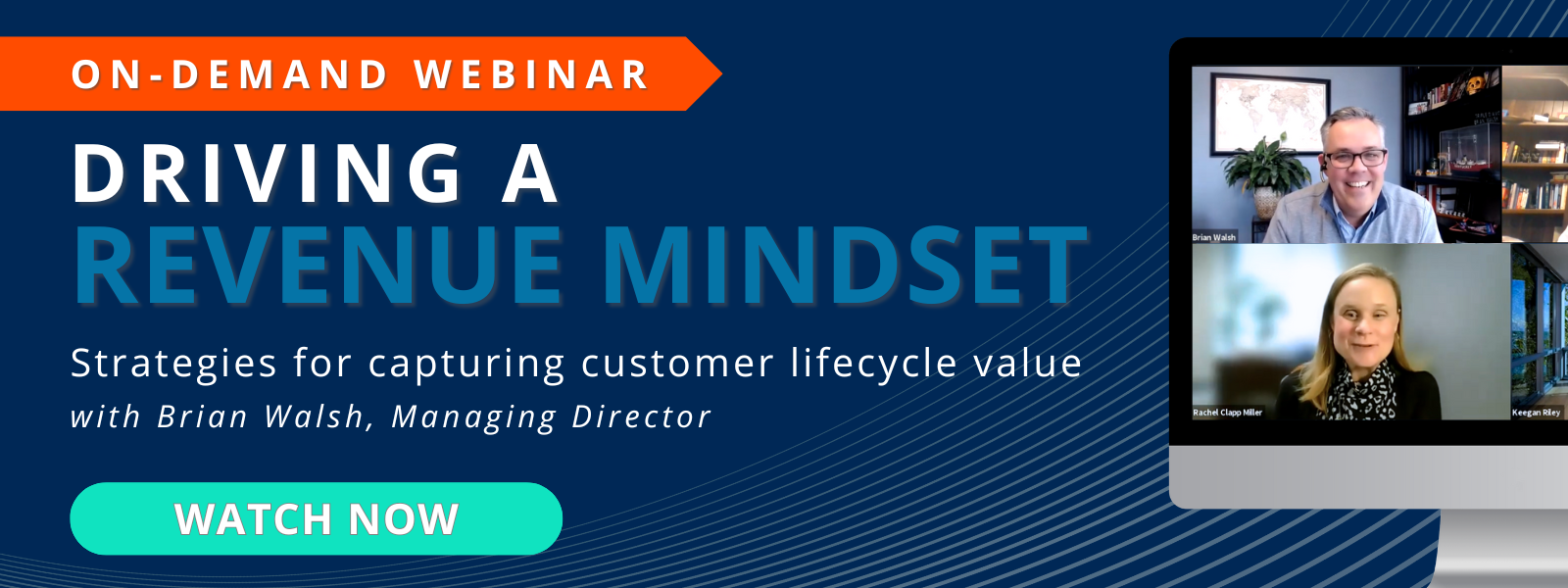
How to Sustain New Sales Behaviors
Categories: Sales Transformation | Adoption and Reinforcement
With any strategic change initiative, there’s always the question of whether or not it will stick. If you’re tasked with ensuring your sales organization can execute against aggressive growth goals, you’ll want to ensure that the investment you're making in a new approach pays off. Whether you are wrapping up a sales kickoff or delivering a new training initiative to your team, the ROI of the new strategy depends on your post-implementation plan.
Building sales capabilities and driving ongoing reinforcement is not easy. Even veteran leaders aren’t immune to the risks that come with investing coveted time and resources in a sales transformation initiative. However, experience does provide insight on what not to do and how to lead from the front in a way that drives ongoing results.
Sales leaders who have an optimized sales engine in place understand that you need the right building blocks that support behavior change and nurture successful adoption. These five components are critical to sustaining sales behaviors long after the rollout of a transformation initiative.
5 Components to Driving Ongoing Adoption & Consistent Execution
It’s important to understand that achieving sales transformation is a process, not an event. Sales transformation advances through many stages that build on one another. Together, these disciplines form a powerful foundation for the successful adoption of major sales initiatives at the organizational level.
If you’ve worked with us before, you may be familiar with this approach, which we refer to as the PRIMR methodology to driving long-term sales success. The five foundations of successful adoption are: Priority, Relevance, Integration, Measurement, and Reinforcement.
1. Priority
If your initiative isn’t seen as a priority by the company as a whole, it will be difficult to sustain.
Initiatives that drive lasting results have leaders up and down the company leading from the front, committing to the inspection and reinforcement of new training concepts, methodologies and processes. This critical leadership buy-in and reinforcement from supporting departments won't happen if your sales transformation initiative is “just another sales program or training." Aligning your intitiative to company objectives is an effective way to ensure it becomes a priority with cross-functional teams. Find ways to articulate how changing sales behaviors will support each department leader in meeting their specific KPIs and growth goals.
In this on-demand webinar, John Kaplan runs through best practices for getting other department leaders to see value in your initiative, in a way that will ensure the company-wide support necessary to make new sales behaviors stick. This support from other company leaders will be critical to executing on the next four components below.
2. Relevance
Check in at each stage of your initiative to ensure you are demonstrating the relevance to specific roles and the company at large. Reinforcement and execution of new sales behaviors and methodologies can easily break down if reps don’t have practical ways to execute on them.
Build relevance and practicality into your strategic sales initiative by:
- Tailoring the curriculum and reinforcement plans to real-world selling situations that the sales organization encounters on a day-to-day basis. This could mean separate trainings for different types of reps (e.g., BDRs and Enterprise reps)
- Getting other company leaders to weigh in on how changes may affect how their organizations operate with the sales team and interact with customers during the engagement process
- Developing new tools and processes that are sales consumable and customized to your buyers and sales process
Ensure that each department leader is communicating to their teams not just the importance of adhering to the training, but how their outcomes will be improved if they do. Too often, new methodologies are seen as boxes to check for individual contributors, rather than tools for success. Front-line managers are critical to driving this understanding with their teams. Their approach will determine how your initiative is received, so it's important to get managers aligned on coaching and demonstrating the value of the new sales behaviors.
Making your strategic sales initiative relevant and customized to your organization ensures salespeople can easily execute on the front line and integrate new behaviors into their everyday tasks. There are various ways you can implement relevancy into the rollout of new sales capabilities - consider these best practices companies are using today.
3. Integration
Much like the relevance phase of delivery, your reinforcement efforts should integrate into key components of the sales organization.
Make consistent execution practical and simple for your talent by integrating new methodologies into your CRM and any other tools and content hubs that your GTM teams use on a daily basis.
Consider what integration means for your organization. Where can you reinforce these concepts to make them visible and easy for your sales team to reference on sales calls, in deal reviews, etc? Think through the various channels you'll need to integrate in advance. Consider how integration may also include drafting new content, processes and tools into other best practices or initiatives already in place. This step makes your strategic changes feel more like an evolution of what the sales team is doing already.
CRM integrations are a great first step, and they can play a major role in driving consistent execution. Other ways you can practically integrate new methodologies into your sales team’s everyday tasks include sales presentations, pre-call tools, manager coaching guides, and role-play demos.
Keep in mind, integration should expand the footprint of the transformational initiative to include other organizations within the company (e.g., marketing, product development). Beyond sales team adoption plans, leaders should take other departments into account to ensure new capabilities are supported and reinforced, a few examples being:
Product: Implement communication channels where Product can share new solution releases and support sales ability to sell these solutions in a way that aligns with changed sales behaviors.
Marketing: Reframe case study templates, customer testimonial interview questions and other template collateral to ensure the end result supports sales’ ability to leverage those resources when executing changed behaviors.
HR and hiring: Update hiring materials to ensure new candidates will be capable and possibly familiar with the new sales capabilities you’re implementing through your sales initiative.
Aligning the broader revenue team behind behavior change is critical to the success of an initiative. Here's a link to a resource where we go further into depth on how to align customer-facing teams to execute on the revenue strategy.
4. Measurement
Behavioral and business measurements are integral to your initiative’s ongoing success. Driving discipline and accountability around new sales behaviors is hard to do when salespeople don’t have a clear picture of what good will look like and how they’ll be measured. Define your metrics of success, and don’t leave any room for ambiguity.
Tie the results of your initiative to the key performance indicators for the sales organization and individual roles (front- and second-line management, reps, even BDR/SDRs if applicable). Communicate your progress on these benchmarks regularly. Everyone should know where you stand on successfully changing behaviors, the outcomes the change is driving and any developments or corrections taking place.
Consider how you can best leverage your managers to measure results in their teams and coach reps to success when they notice salespeople are struggling to adopt new behaviors. Provide managers with a cadence and tools to assess their sales team so they can effectively provide guidance, ensure accountability and drive ongoing consistency.
As a sales leader, consider how you can gain line-of-sight into the adoption and application of the methodologies as well. Make it simpler to prove ROI and course-correct execution challenges from the top down by integrating innovative ways to measure front-line performance. Consider a CRM tool that can help you and your front-line managers track execution and make data-informed decisions as challenges arise.
5. Reinforcement
Successfully executing on each concept above will support your ability to drive lasting reinforcement. Leverage those concepts as you build your execution plan for driving ongoing adoption and accountability across your customer-facing revenue organization.
Ensure you have a plan for reinforcement training in place. The reality is that most learners will not retain new concepts in an applicable and meaningful way after a single exposure, especially when they've processed a wealth of new information in a short period like an SKO or training event. Your event is the foundation, but the tools you choose to encourage ongoing learning will define your initiative. Invest in a continuous learning platform that keeps your team engaged after the initial event.
In analyzing a potential continuous learning platform, consider these best practices used by today's leaders, especially in a remote working environment. The following features can help you find a learning platform that accelerates adoption of your training initiative:
- Forums and communication channels to help salespeople share best practices and seek advice from peers
- Regular newsletters, updates and memos that highlight tips for effective execution, solutions to relevant challenges in the market, and call out successes as a way of sharing what’s working well for others
- Live interactive events and learning opportunities with veteran sales professionals who are experienced in your new methodologies and best practices
- Ongoing learning courses for personal professional development of not just salespeople, but development representatives and managers
After the launch event ends, reinforcement falls heavily on managers. Managers work with their sales reps on the front line, meaning they will be the first to hold your reps accountable for using new tools and methodologies. Managers are also your reps first line of support when they’re struggling to apply a critical concept to their deals in a way that moves them forward at a high value. Ensure your managers are experts in new sales processes or methodologies. Enabling managers to be valuable coaches should be one of your first priorities when it comes to reinforcing your sales initiative.
Drive Alignment Around A New Mindset
Implementing new sales behaviors requires aligning your entire GTM team behind a new mindset. When all customer-facing teams work together to deliver the greatest possible value for the customer, your organization walks away with the best possible revenue outcomes. That level of execution is what we call the Revenue Mindset.
Join our upcoming webinar hosted by Brian Walsh, sales veteran and Force Management Managing Partner, as we dive into strategies for aligning your commercial organization to drive greater commitment from buyers at a premium price. We'll share the cross-functional approach leveraged by today's top leaders to achieve next-level execution of their topline revenue strategy at the deal level.


